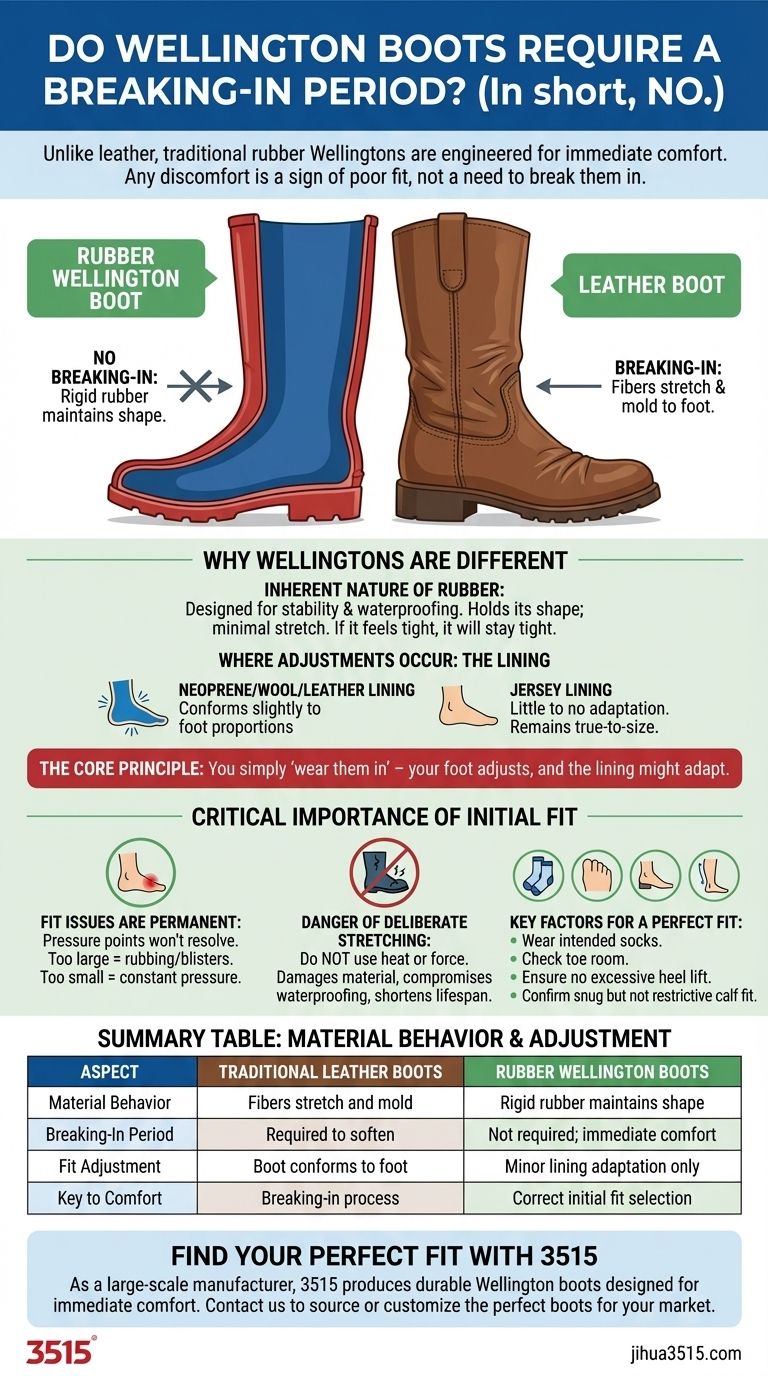In short, no, traditional rubber Wellington boots do not require a "breaking-in" period. Unlike leather boots that must soften and stretch, rubber Wellingtons are engineered for immediate comfort and to hold their shape. Any initial discomfort is more likely a sign of a poor fit than a need for the boot to conform to your foot.
The core principle to understand is that Wellington boots don't break in; you simply "wear them in." The rigid rubber shell will not change shape, but the internal lining may adapt slightly, and your feet will adjust to the new environment.

Why Wellingtons Are Different
The concept of breaking in a boot comes from traditional materials like leather, which contain fibers that gradually stretch, flex, and mold to the unique shape of your foot. Wellingtons operate on a completely different principle.
The Inherent Nature of Rubber
Rubber is chosen for its stability and waterproof properties. It is designed to maintain its original shape and size over time.
This means that if a boot feels too tight or pinches in a specific area when you first try it on, it will almost certainly continue to do so. There is minimal stretch in the material itself.
Where Minor Adjustments Occur: The Lining
While the rubber shell is static, the boot's internal lining can conform slightly with wear. This is where a subtle "wearing-in" process happens.
Linings made from neoprene, wool, or leather will compress and mold to your foot's proportions, enhancing the overall fit and comfort over time. In contrast, simple jersey linings offer little to no adaptation and will remain true-to-size.
An "Adjustment Period," Not a "Breaking-In Period"
It is helpful to think of the initial wears as an adjustment period. This time allows your foot to become accustomed to the boot's shape and for you to identify any potential issues with the fit.
Wearing new boots for short durations at first is a wise precaution, not to change the boot, but to confirm its suitability before a long day of use.
The Critical Importance of Initial Fit
Because Wellingtons do not meaningfully change shape, getting the fit right at the point of purchase is the single most important factor for long-term comfort.
Fit Issues Won't Resolve Themselves
Unlike leather boots where tightness can ease over time, a pressure point in a rubber boot is permanent. A boot that is too large will cause rubbing and blisters, while a boot that is too small will create constant pressure.
The Danger of Deliberate Stretching
You should never attempt to deliberately stretch rubber Wellington boots. Applying heat or force is far more likely to damage the material, compromise the waterproof seams, and shorten the boot's lifespan than it is to improve the fit.
Key Factors for a Perfect Fit
When trying on new Wellingtons, always wear the type of socks you intend to use with them. Pay close attention to having enough room for your toes, ensuring your heel doesn't lift excessively when you walk, and confirming a snug but not restrictive fit around your calf.
Making the Right Choice for Your Goal
Your approach should be centered on verifying the fit, not on trying to alter it.
- If your primary focus is all-day comfort for an event: Choose a boot with a high-quality lining like neoprene or leather that will offer slight adaptation and cushioning.
- If your primary focus is ensuring a pain-free purchase: Wear the boots around your house for an hour or two on a clean surface. This is your only reliable window to detect fit issues before committing to them.
- If you feel any distinct pinching or tightness: Do not assume it will go away. This is a clear sign of an incorrect fit, and you should try a different size or model.
Ultimately, choosing the right Wellington boot is about selection, not modification.
Summary Table:
| Aspect | Traditional Leather Boots | Rubber Wellington Boots |
|---|---|---|
| Material Behavior | Fibers stretch and mold to the foot | Rigid rubber shell maintains shape |
| Breaking-In Period | Required to soften and adapt | Not required; comfort is immediate |
| Fit Adjustment | Boot conforms to foot | Minor lining adaptation only |
| Key to Comfort | Breaking-in process | Correct initial fit selection |
Find Your Perfect Fit with 3515
As a large-scale manufacturer, 3515 produces a comprehensive range of footwear for distributors, brand owners, and bulk clients. Our production capabilities encompass all types of shoes and boots, including durable Wellington boots designed for immediate comfort and superior performance.
Let us help you source or customize the perfect Wellington boots for your market. Contact us today to discuss your needs and discover how we can add value to your business.
Visual Guide

Related Products
- Factory Direct Wholesale Rain Boots Durable Waterproof & Fully Customizable
- Wholesale Safety Footwear Manufacturer for Bulk & Custom OEM Orders
- Factory-Direct Wholesale Canvas Boots with High-Traction Rubber Soles
- High Performance Fire-Retardant Waterproof Safety Boots
- Wholesale Waterproof Tactical Boots Custom Suede & High-Traction Soles
People Also Ask
- What are rain boots made of? Discover the best materials for ultimate waterproof protection.
- What are the limitations of rain boots in certain climates? Find the Right Footwear for Your Weather
- What are the distinctive features of rain boots? Unmatched Waterproof Protection Explained
- What are the drawbacks of rubber boots regarding breathability and comfort? Understanding the Moisture Trap
- What factors should be considered when choosing rain boots? Find the Perfect Boot for Your Needs



















